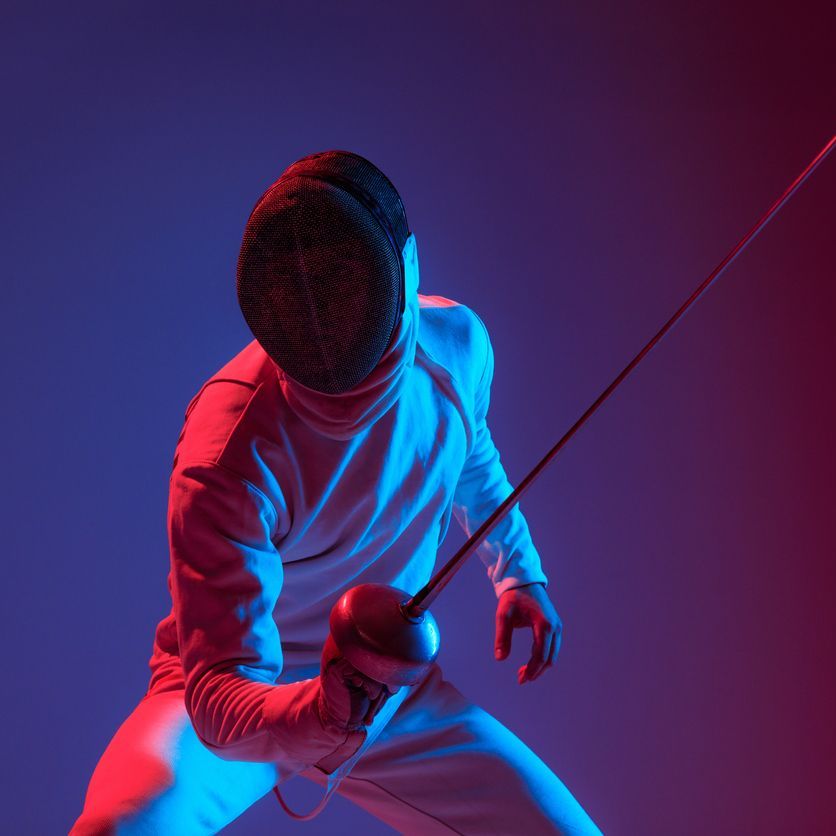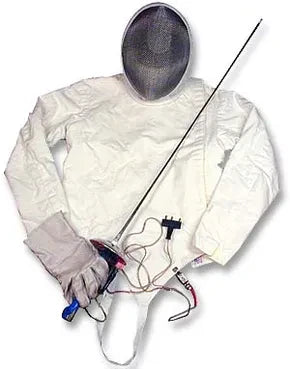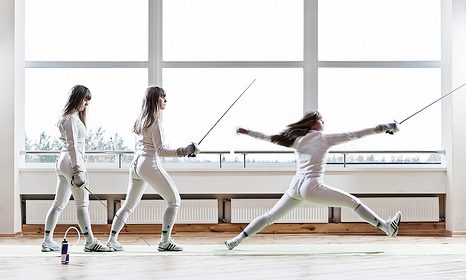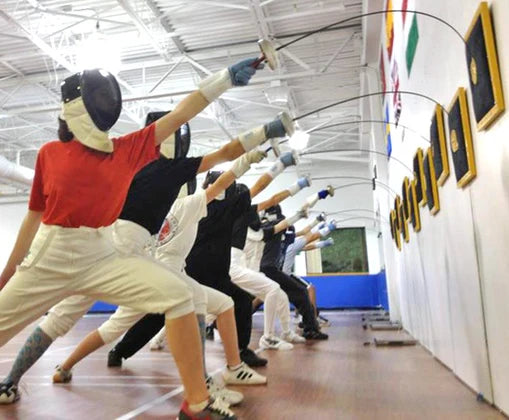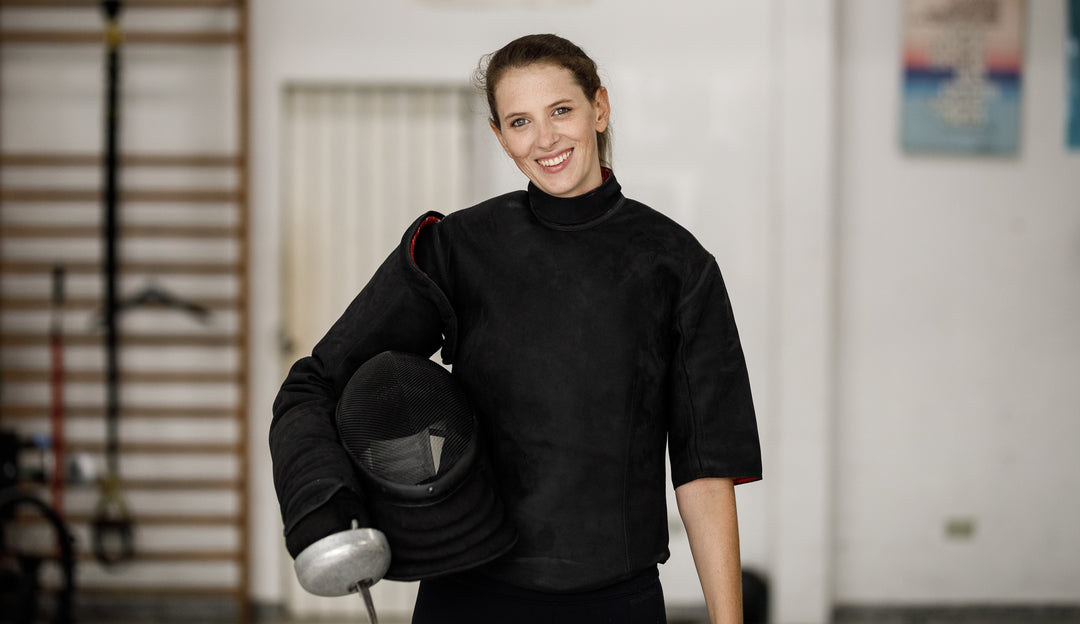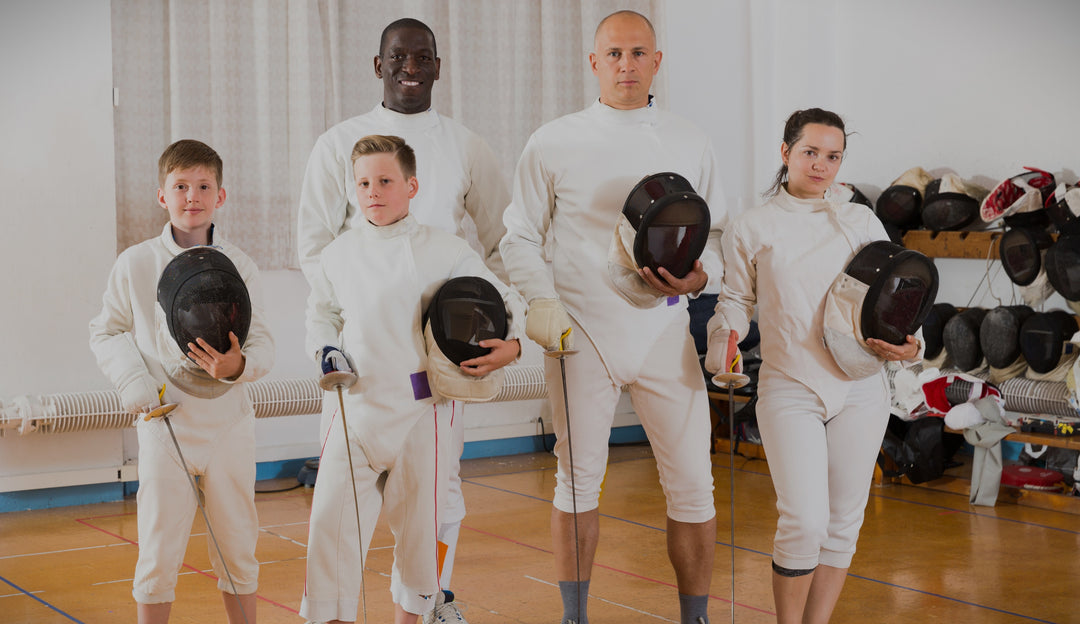Diving into epee fencing can feel like learning a whole new language, but getting to know your gear is the best first step you can take. Your essential fencing equipment epee kit includes the epee itself, a protective mask, a tough jacket and underarm plastron, a glove for your weapon hand, and breeches. Think of it as a complete system designed to keep you safe so you can focus on your footwork and strategy.
Your First Guide to Epee Fencing Equipment
Your equipment is your modern-day sword and armor. Every single piece is there for two reasons: performance and safety. When your gear fits right and works as it should, you can hit the strip with the confidence you need to compete. This guide will break down the complete epee setup and explain the "why" behind each component.
The Weapon: The Epee
At the very heart of your kit is the epee. It’s not just a pointy stick; it’s a finely tuned tool with several crucial parts that all have to work together perfectly. Understanding how it’s built will help you appreciate what it does and make a smarter choice when you're ready to buy your own. For anyone just starting, a standard practice epee is a fantastic way to get your feet wet.
A complete epee is made up of:
- The Blade: This is the long, triangular part of the weapon. Epee blades are stiffer than foil blades and have a spring-loaded tip at the end that presses down to register a touch.
- The Bell Guard: That big, bowl-shaped piece of metal is there to protect your weapon hand, which is a prime target in epee fencing.
- The Grip: Grips come in different styles, most commonly the straight French grip or the form-fitting Pistol grip. The one you choose really affects how you hold and maneuver the weapon.
- The Pommel: This is a weighted nut that screws onto the end, holding the whole assembly together and helping to balance the blade.
The Protective Uniform
Your safety on the strip is non-negotiable, and that’s why a proper protective uniform is an absolute must. Every piece is specifically designed to take a hit from an opponent's blade, letting fencers go all out without worrying about injury.
A well-fitted uniform isn’t just about protection—it’s about freedom of movement. Your gear should feel like a second skin, enabling you to lunge, retreat, and react without restriction.
The key items start with the mask, which shields your entire face and head. Then there's the puncture-resistant jacket. Worn underneath the jacket is a plastron, an extra layer of defense for your weapon arm and the side of your torso. Finally, a padded glove protects your weapon hand, while durable breeches cover your legs to complete the armor every epee fencer needs.
Understanding the Anatomy of an Epee
An epee isn't just a simple piece of steel—it's a precision instrument made of four distinct parts that have to work together perfectly. The choices a fencer makes for each component can completely change the weapon's balance, feel, and how it performs on the strip. Getting to know this anatomy is your first step toward building the ideal fencing equipment epee for your unique style.
Every epee is built from four core components: the blade, bell guard, grip, and pommel. Each piece has a specific job, from delivering a clean touch to protecting your hand. When you put them all together correctly, you get a weapon that’s not just effective, but also legal for competition.
The Blade: The Heart of the Weapon
The blade is easily the most recognizable part of the epee. It’s a long, triangular, and fairly stiff piece of steel designed purely for thrusting. Unlike the whippier foil or sabre blades, epee blades are built to be more rigid—a nod to the weapon's origins in dueling, where pinpoint accuracy and a solid hit were everything.
Blades generally fall into two categories: standard (non-FIE) and FIE-certified. Standard blades are great for club practice and local tournaments, offering a good mix of durability and affordability. FIE blades, on the other hand, are crafted from maraging steel. This special alloy isn't just stronger; it's designed to break cleanly without splintering into dangerous shards, a critical safety requirement for national and international events.
The blade you choose has a massive impact on how the weapon feels. A stiffer blade gives you more direct, precise control over the point. A more flexible one might feel whippier and quicker, which can be an advantage for actions like disengages.
The infographic below shows the typical blade lengths and weights for different age categories, giving you a sense of how the weapon is adapted for fencers of all sizes.
As you can see, while there's a big jump in blade length between junior and senior weapons, the weight doesn't change as drastically. It's a great reminder that in epee, balance and feel are often more important than sheer mass.
The Bell Guard and Grip: Your Control Center
The bell guard is that big, bowl-shaped shield protecting your weapon hand. In epee, your entire body is a valid target, so keeping your hand safe is non-negotiable. Its 13.5 cm diameter offers a ton of coverage from an opponent's incoming point.
Right behind the bell guard is the grip, and this is where your personal preference really shines through. There are two main styles you’ll see everywhere:
- French Grip: A simple, straight handle that lets you extend your reach and use subtle finger movements for point control. Some fencers hold it near the end—a technique called "posting"—to squeeze out a few extra inches on a lunge.
- Pistol Grip: An orthopedic, form-fitting handle designed for maximum blade control and power. Grips like the Visconti or Belgian lock your hand into a very secure position, making powerful parries and decisive point-work feel much more natural.
The grip you pick really shapes your entire fencing game. The French grip is a favorite among fencers who play a tactical game of distance and finesse. The pistol grip, however, is built for aggressive, close-quarters fencing where raw power and control are king. Tying it all together is the pommel, a weighted nut at the very end that screws everything in place and provides the counterbalance that gives the epee its beautifully balanced feel.
Choosing between a French and Pistol grip is one of the most important equipment decisions an epee fencer makes. To help you decide, here’s a quick breakdown of what each style brings to the table.
Comparing Epee Grip Styles: French vs. Pistol
| Feature | French Grip | Pistol Grip (e.g., Visconti, Belgian) |
|---|---|---|
| Primary Advantage | Longer reach and finesse. Allows for "posting" to gain extra inches. | Superior blade control and power. Locks the hand in for strong, intuitive actions. |
| Tactical Focus | A game of distance, timing, and subtle point manipulation. Ideal for counter-attacking and keeping opponents at bay. | Aggressive, close-quarters fencing. Excels at powerful parries, remises, and decisive point-work. |
| Learning Curve | Steeper for beginners, as it requires more finger and wrist strength to control the point effectively. | More intuitive for beginners. The ergonomic shape makes it easier to manage the blade and develop strong fundamentals. |
| Best Suited For | Patient, tactical fencers who prefer to control the bout with distance and precision. | Aggressive fencers who rely on strength, powerful blade actions, and dominating the middle of the strip. |
| Grip Technique | Held loosely, allowing for fine-motor control with the fingers. Fencers can adjust their hand position along the grip. | Held firmly, with the hand locked into a specific, ergonomic position that provides maximum leverage. |
Ultimately, neither grip is "better"—they just support different styles of fencing. The best way to find out which one is right for you is to try them both. Many fencers start with one and switch later as their game evolves.
Dressing for the Duel: Protective Gear Essentials
In epee, your gear is much more than a uniform—it's your armor. Every piece works together as a system, designed to let you fence with total confidence, knowing you’re protected from head to toe. This lets you focus entirely on your strategy and technique, not on the incoming tip of your opponent's blade.
Think of your protective kit like layers of an onion. Each one adds a crucial level of defense, starting with the most vulnerable areas and building outward. This layered approach ensures that even a well-placed, forceful touch gets absorbed safely, turning a potential injury into just another point on the scoreboard.
The Foundation of Safety: Your Jacket and Plastron
The fencing jacket is your primary shield. Made from tough, puncture-resistant fabric, it covers your torso and arms, which are common target areas. The fit is key here; it should be snug enough to prevent a blade from catching on loose material, yet flexible enough to allow a full range of motion for a lunge or parry.
Worn underneath the jacket is the plastron, also known as an underarm protector. This is a non-negotiable piece of safety equipment. It provides an essential secondary layer of protection over your weapon arm and the side of your torso, reinforcing the area most likely to take repeated hits.
Head and Hand Protection: The Mask and Glove
Your fencing mask is arguably the most critical piece of protective equipment you'll own. Its steel mesh is built to withstand significant impact, while the conductive bib ensures any touches to this area are registered by the scoring machine. A proper fit is non-negotiable for both safety and comfort, as it prevents the mask from shifting during a bout.
Your weapon hand is constantly in the line of fire, which makes the fencing glove absolutely indispensable. This padded gauntlet protects your hand and wrist from strikes while still offering the grip and dexterity needed to control your epee. For extra comfort during long sessions, some fencers add a soft cushion like an epee felt pad inside their bell guard for a bit of added shock absorption.
Understanding Newton Ratings
When you’re shopping for a jacket, plastron, or breeches, you’ll come across "Newton" or "N" ratings. This number simply tells you how puncture-resistant the fabric is—in other words, how much force it can take.
- 350N Gear: This is the standard for most club practices and local competitions. It provides solid, reliable protection for everyday fencing.
- 800N FIE Gear: This is the highest level of protection, required for national and international (Fédération Internationale d'Escrime) tournaments. The fabric is significantly tougher and built to a higher standard.
For beginners, 350N gear is perfectly adequate and much easier on the wallet. You only need to invest in 800N FIE equipment if you plan to compete at higher-level, sanctioned events. Always check the specific requirements for any tournament you enter.
Completing the uniform are the breeches, which are knee-length pants made from the same durable material as the jacket. When paired with long socks, they ensure your legs are protected all the way down to the shin. Every single piece of your fencing equipment epee kit works in concert, providing the comprehensive safety needed for this demanding sport.
Choosing Your First Set of Epee Equipment
Buying your first complete set of epee gear is a huge milestone. It’s the moment you go from borrowing club equipment to truly investing in your fencing journey. This guide will walk you through the process, helping you make smart choices without feeling overwhelmed.
First things first: talk to your club. Many clubs have specific requirements for gear, especially for safety standards or even preferred brands. They’ll tell you exactly what you need for practices and local tournaments, which keeps you from buying unnecessary or non-compliant items right out of the gate.
Starter Kits Versus Buying Separately
One of the biggest decisions for any new fencer is whether to grab a pre-packaged starter kit or buy each piece on its own. Both paths have their pros and cons.
- Starter Kits: These bundles are the definition of convenient and are often easier on your wallet. They typically include all the basics—mask, jacket, glove, plastron, and a weapon—making it a simple, one-stop shop. The trade-off? You get less say in the individual components.
- Buying Separately: This route gives you total control. You can splurge on a high-quality mask but save on a basic jacket, for instance. It definitely takes more time and research, but it lets you build a kit that’s perfectly tailored to you.
For most newcomers, a starter kit is a fantastic entry point. It gets you on the strip quickly with everything you need, and you can always upgrade individual pieces, like your blade or grip, as your skills and preferences evolve.
Setting a Realistic Budget
Fencing equipment has come a long way, but the cost can still be a hurdle. The good news is that manufacturers have recognized this and now offer plenty of high-quality, entry-level gear designed just for beginners. You can read more about industry trends in this in-depth analysis of the fencing equipment market.
A complete beginner set usually runs somewhere between $200 to $400. When you're planning your budget, put the most money toward the items that have the biggest impact on your safety and comfort.
Your mask and glove are the two most important investments you'll make. A well-fitting mask is non-negotiable for safety, period. A comfortable glove directly affects how you control your epee. These are not the places to cut corners.
Common Mistakes to Avoid
Navigating your first gear purchase can be tricky, but knowing a few common pitfalls can save you a lot of time and money. One of the most frequent mistakes is overspending on a high-tech FIE blade way too early. A durable, standard blade is more than enough to learn the fundamentals. A reliable weapon like this standard electric epee with a pistol grip is a great starting point, offering a nice balance of control and affordability.
Another classic mistake is messing up the fit. A jacket that’s too tight will restrict your movement, while a mask that’s too loose is a serious safety hazard. Always—and I mean always—take accurate measurements and check the sizing charts before you click "buy." Remember, your first set of gear is all about building a solid foundation for your future in the sport.
Keeping Your Gear in Fighting Shape

Your fencing equipment epee is a serious investment. Like any high-performance tool, it needs regular upkeep to work properly. Consistent care not only makes your gear last longer but also keeps it safe and reliable, saving you from the frustration of an equipment failure during a critical bout.
Think of your epee as a sensitive instrument. The most common points of failure are the delicate wiring running down the blade and the spring-loaded tip. It’s a great habit to give the wire a quick visual check for nicks or fraying before and after every practice. At the same time, make sure the tip moves smoothly without sticking.
A fencer's nightmare is a weapon that fails to register a touch. More often than not, the culprit is a simple, fixable issue—like a loose wire in the bell guard or a dirty point. Learning basic troubleshooting will make you a far more self-reliant fencer.
Getting comfortable with how your weapon is put together is the first step toward self-sufficiency. Knowing how to tighten a loose pommel or re-seat a connection can save you precious time on the strip.
Maintaining Your Epee Weapon
Your epee blade is going to get bent in practice. That's a given. Gently straightening it is a normal part of fencing, but always do it carefully over your knee or on a non-abrasive surface. Avoid sharp, aggressive bends, which weaken the metal over time and will cause it to break prematurely.
The tip of your epee is another area that needs close attention. It contains tiny springs and contact points that can get gummed up with grime or sweat, causing it to fail a weight test or not register a touch.
- Tip Screws: Check that the two tiny tip screws are secure. If they come loose, the tip can malfunction or even fall apart mid-bout. Keeping spares is always a good idea. You can find quality NEPS Advanced Epee Tip Screws to keep your weapon in top condition.
- Cleaning the Point: Every so often, use a cotton swab with a little rubbing alcohol to gently clean inside the tip barrel. This removes any grime that could interfere with the electrical contact.
Caring for Your Protective Uniform
Your uniform’s main job is to protect you, so keeping it clean is essential for both hygiene and the integrity of the material. Most jackets, plastrons, and breeches are machine washable, but always check the manufacturer’s tag for specific instructions first.
Wash your whites in cold water and hang them to dry. Never use a machine dryer. The high heat can damage the synthetic fibers that give the uniform its protective qualities. For your mask, wipe down the inside padding with a damp cloth and let it air dry completely. This will prevent rust from forming on the mesh and keep it fresh.
Your Top Epee Equipment Questions, Answered
Stepping into the world of epee fencing can feel a little overwhelming, especially when it comes to the gear. You've probably got a dozen questions floating around your head. What's the right stuff to buy? How much is this going to cost? What’s the deal with foil and sabre?
Getting clear, straightforward answers is the key to making confident choices. So, let’s tackle some of the most common questions fencers have about their equipment. We'll clear up the confusion so you can get back to what really matters—your time on the strip.
What Is the Main Difference Between Epee, Foil, and Sabre Equipment?
The biggest differences come down to three things: the weapon itself, the valid target area, and the uniform you need to wear. Each one creates a totally different strategic game.
- Epee: Think of this as the "anything goes" duel. It’s a heavier thrusting weapon, and the entire body—head to toe—is a valid target. That's why the bell guard is so large; it’s essential for protecting your weapon hand, which is fair game and a common target.
- Foil: This is a much lighter, more flexible thrusting weapon where the game is restricted to the torso. To make scoring work, fencers wear a conductive jacket called a lamé that covers this specific target area.
- Sabre: This is a slashing and thrusting weapon. The action is fast and furious, with the target being everything from the waist up (except the hands). This requires a conductive lamé, mask, and glove to register touches.
Do I Need FIE Certified Equipment to Start Fencing Epee?
Absolutely not. When you’re just getting your start at a local club, standard 350N-rated equipment is more than enough protection for practice and beginner-level competitions. It’s safe, reliable, and way more affordable.
FIE (Fédération Internationale d'Escrime) certified gear, which is rated at a tougher 800N, is only required for fencers competing at higher levels, like national or international tournaments. The best path is to start with the standard gear and only upgrade if you decide to chase that level of competition.
Your first priority should be getting comfortable with the fundamentals. Investing in top-tier FIE gear too early is an unnecessary expense; focus on mastering your footwork and bladework with solid, entry-level equipment first.
This approach saves you a good chunk of change and makes sure your initial investment is focused on learning and enjoying the sport, not on gear you don't need yet.
How Much Does a Complete Beginner Epee Set Cost?
You can expect a complete beginner set of epee equipment to cost somewhere between $200 and $400. This range will typically cover all the essentials you need to get on the strip safely.
A typical starter kit will include:
- A non-electric or basic electric epee
- A durable fencing mask
- A protective jacket and plastron (that's the underarm protector)
- A glove for your weapon hand
- A pair of fencing breeches (the knee-length pants)
Of course, prices will vary a bit depending on the brand and the specific items, but these entry-level kits are designed to be a safe and affordable entry point for new fencers.
What Is the Most Important Equipment to Invest in First?
When you’re buying your first set of gear, your priorities should always be safety and comfort. A piece of equipment that doesn't fit right isn't just annoying—it can be a real safety risk.
The single most critical piece of gear is a well-fitting mask. It has to be snug enough that it won’t shift around or come off during a bout, protecting your head and face completely. After the mask, a properly sized glove and jacket are next on the list. These protect key target areas and need to let you move freely without feeling restricted.
As for the weapon? A basic, durable epee is all you need to get the fundamentals down.
Ready to gear up? Explore a full range of high-quality fencing equipment for every skill level at Fencing Club. Find your perfect starter kit or upgrade your gear today at https://fencing.club.




